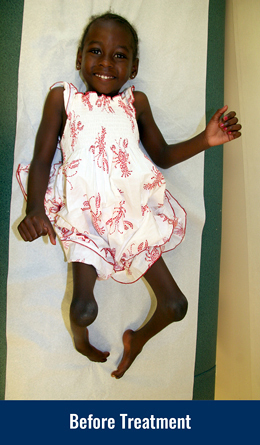Contractures
What is a joint contracture?
A contracture is a condition affecting any joint of the body in which passive range of motion is reduced. Other names for joint contractures include tightness or stiffness. Contractures range from severe limitations of movement (having a range of motion of only a few degrees) to only minor differences when compared to the normal range. The degree of debilitation from a contracture depends on its location and how much motion is preserved. Challenges facing patients with joint contractures include: pain or weakness when trying to use the affected joint, soft tissue compromise, difficulty performing certain activities of daily living (dressing, eating and basic hygiene) and overall reduction of quality of life. Specific symptoms most often depend on which particular joint is involved. For example, a contracture of the hand/finger may result in difficulty performing fine motor tasks or weakness of grip, whereas a contracture of the knee or ankle may impair walking or cause a limp.
What causes a joint contracture?
Joint contractures can result from a multitude of problems. Injury to a joint leads to contracture by affecting either structures within the joint itself (bone, cartilage) or outside of it (muscle, tendon, skin). Common causes may include prolonged periods of immobilization, trauma affecting a joint, significant soft tissue injury such as a burn, and neurologic injury or disease. Additionally, contractures may be congenital (a baby is born with it) in association with certain birth defects such as arthrogryposis or muscular dystrophies. Contractures tend to develop over time in the post-traumatic setting and may be asymptomatic until a certain level of disability is reached.
How common are joint contractures?
The prevalence of a joint contracture depends on its cause. For older individuals affected by prolonged periods of immobilization, contractures may occur with some frequency. Contractures due to traumatic injury vary based on the specific joint, with the elbow and ankle being the most commonly affected. Contractures caused by significant burns can occur in approximately 30% of patients.
How are joint contractures diagnosed?
Joint contractures are diagnosed predominantly by physical examination. Imaging such as radiographs (X-rays), MRI or CT scans may help categorize bony or soft tissue injury that will ultimately place a patient at risk for developing a contracture, but do not sufficiently describe the severity or level of disability caused by the contracture. A careful history detailing what activities are limited by reduced range of motion is also very helpful in determining a treatment plan. A joint contracture may be diagnosed by any professional knowledgeable about the normal range of motion of upper and lower extremity joints.
What are the treatment options for joint contractures?
The cornerstone of treating joint contractures that are not congenital lies in their prevention. Once a traumatic injury involving a joint is diagnosed, the treatment plan should include measures for the maintenance of joint motion. These may include orthotics to maintain appropriate joint positioning during periods of necessary immobilization, daily re-assessment of weight bearing and range of motion restrictions and regular treatment sessions with physical/occupational therapy professionals.
Once a joint contracture has occurred, the first line of treatment is generally conservative. Specific management strategies will depend on which joint is affected. Modalities of contracture treatment include daily active and passive stretching and the use of bracing and splinting to promote muscle stretch. Should these measures prove ineffective, evaluation by an orthopedic surgeon is recommended to determine whether surgical intervention may be indicated.
Surgical treatment may be effective in the treatment of joint contractures in a variety of situations, depending on the cause. In the post-traumatic setting, extra bone called “heterotopic ossification” may be limiting joint range of motion – this may be resected in order to improve joint mobility. More typically, however, contractures are a result of shortening of localized muscles, tendons, ligaments or the joint capsule (covering over a joint) itself. In these cases, surgery would address the issue by releasing whatever tissue is tight. This may be referred to as a “capsular release,” “tenotomy,” or “muscle recession.” The mainstay of any surgical treatment includes careful post-operative therapy to preserve any motion gained in the operating room.
Why choose the International Center for Limb Lengthening for treatment of joint contractures?
Your doctor at the International Center for Limb Lengthening will take the time to make sure you understand all your options and then will customize your treatment to meet your specific needs. Our patients benefit from our team-centered approach with world-renowned surgeons and specialized physician assistants, nurses and physical therapists. We help patients with joint contractures achieve their best possible result.






